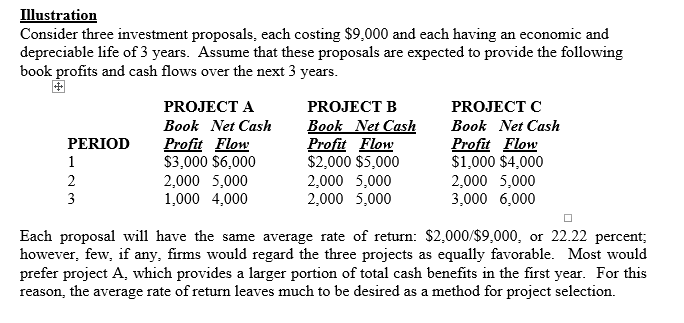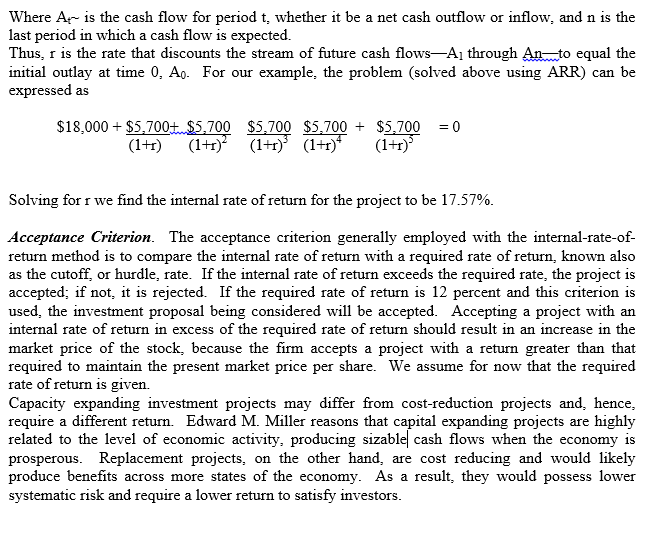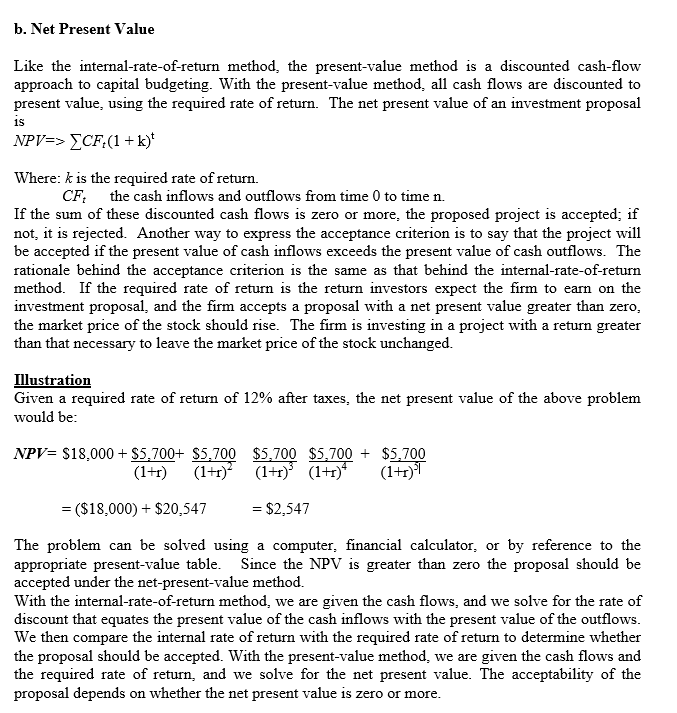1. NON DISCOUNTED METHODS
a. Average Rate of Return (ARR)
This accounting measure represents the ratio of the average annual profits after taxes to the investment in the project. In the previous example of the new machine, the average annual book earnings for the 5-year period are $2,100, and the initial investment in the project is $18,000. Therefore:
Average rate of return (ARR) =$2,100x100/$18,000 = 11.67%
If income were variable over the 5 years, an average would he calculated and used in the numerator. Once the average rate of return for a proposal has been calculated, it may be compared with a required rate of return to determine if a particular proposal should be accepted or rejected.
The advantage of the average rate of return is its simplicity; it makes use of readily available accounting information. Once the average rate of return for a proposal has been calculated, it may be compared with a required, or cutoff, rate of return to determine if a particular proposal should be accepted or rejected. The principal shortcomings of the method are that it is based on accounting income rather than on cash flows and that it fails to take account of the timing of cash inflows and outflows. The time value of money is ignored: benefits in the last year are valued the same as benefits in the first year.

b. Payback Method
The payback period of an investment project tells us the number of years required to recover our initial cash investment. It is the ratio of the initial fixed investment over the annual cash inflows for the recovery period. From the previous example:
Payback period = CO/CF = $18,000/$5,700 — 3.16 years
Illustration:
If the annual cash inflows are not equal, the calculation is more difficult. Suppose annual cash inflows are $4,000 in the first year, $6,000 in the second and third years, and $4,000 in the fourth and fifth years. In the first 3 years, $16,000 of the original investment will be recovered, followed by $4,000 in the fourth year. With an initial cash investment of $18,000, the payback period is 3 years + ($2,000/$4,000), or 3~ years.
If the payback period calculated is less than some maximum acceptable payback period, the proposal is accepted; if not, it is rejected. If the required payback period were 4 years, the project in our example would be accepted. The major shortcoming of the payback method is that it fails to consider cash flows after the payback period; consequently, it cannot be regarded as a measure of profitability. Two proposals costing $10,000 each would have the same payback period if they both had annual net cash inflows of $5,000 in the first 2 years; but one project might be expected to provide no cash flows after 2 years, whereas the other might be expected to provide cash flows of $5,000 in each of the next 3 years. Thus, the payback method can be deceptive as a yardstick of profitability. In addition to this shortcoming, the method does not take account of the magnitude or timing of cash flows during the payback period. It considers only the recovery period as a whole.
The payback method continues as a supplement to other more sophisticated methods. The shorter the payback period the less risky the project and the greater its liquidity in terms of recouping the initial investment. The company that is cash poor may find the method to be very useful in gauging the early recovery of funds invested. There is some merit to its use in this regard, but the method does not take into account the dispersion of possible outcomes—only the magnitude and timing of the expected value of these outcomes relative to the original investment. Therefore, it cannot be considered an adequate indicator of risk. When the payback method is used, it is more appropriately treated as a constraint to be satisfied than as a profitability measure to be maximized.
1. Discounted Cash Flow Methods a. Internal Rate of Return (IRR)
Due to the various limitations of the average rate of return and payback methods, it is generally agreed that discounted cash-flow methods provide a more objective basis for evaluating and selecting investment projects. These methods take account of both the magnitude and the timing of expected cash flows in each period of a project’s life. The two discounted cash-flow methods are the internal-rate-of-return and the net-present-value methods. The internal rate of return for an investment proposal is the discount rate that equates the present value of the expected cash outflows with the present value of the expected future inflows. It is represented by that rate, r, such that;
?At[(1 +r)t = 0
t=1 to n


Titany answered the question on
October 12, 2021 at 11:23